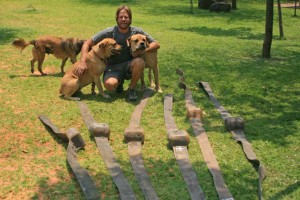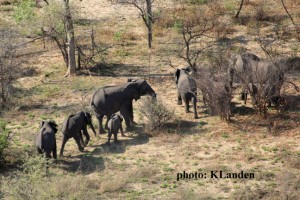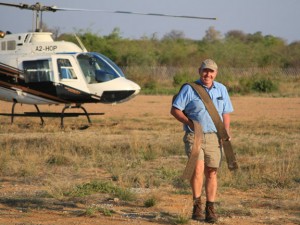Goodbye wishes to Elephant Ambassadors…
Elephants Without Borders’ (www.elephantswithoutborders.org) busy field season is finally beginning to slow down. As ominous clouds are developing above with the threat of highly anticipated coming rains, we have a tendency to hold off from continuing field excursions. When the rain hits, the wildlife disperse and we cannot do anything but wait to see what happens. However, with the chance of catching our breathe comes the opportunity to also catchup on office work. For me, a big part of that is reporting to all our friends and fans on what has been keeping us busy!

Dr. Mike Chase with retrieved elephant collars
So, why do we work in the field at the extreme heat of the year? During the dry season elephants tend to slow or even halt their long-distance travels and congregate in close proximity to water sources. (download elephant movement maps) Anyone who has traveled to Botswana and visited the Chobe River in September can attest to that! Some elephants stick close to the permanent river systems, some at artificial waterholes, some at natural pans (until they dry out,) and some were quite lucky to find flows in once dry river beds that have not had water in many years. This gives us a much easier advantage to find and reach our elephants, rather than the time when they are widely dispersed, that is, when they can find water and food almost anywhere. So, it is during the dry season when we head out to retrieve collars off elephants, those which the batteries on the telemetry unit are about to fail, or to deploy new collars onto other elephant ambassadors.
Maneuvering the helicopter over the elephant can be difficult
This season, we were quite busy and took collars off eleven elephants and deployed eight others, in a wide-variety of areas… thus far! (Why collar and track elephants? click here) The exercises are quite similar, but I feel retrieving a collar is much trickier than deploying one. Taking the collar off is as simple as cutting the band and within minutes the team is scrambling back to the helicopter, but deploying it takes some time as it needs to be fastened on correctly and carefully. However, the big difference is that while retrieving a collar, we must find and focus on one particular elephant, rather than just choosing any elephant in a herd. No matter the circumstance. We spend much more time tracking the particular collared elephant and assessing the conditions as to when and how would be the best way to get to them.
At times, it is rather easy… that is, if we are lucky. Before the day begins, we try to check the satellite signal via our computers to attain a coordinate, then fly to that point and look for the one with the collar. Sounds simple enough, but isn’t always that easy. This time, we were met with some success and some extreme frustrations and a few of the collars were “data-loggers”, which are collars that do not have satellite capability and only VHF frequencies (meaning, we need to find them solely by physically tracking without a known coordinate.) So one can imagine, we spent many hours tracking in the small 4-seater Cessna, each time trying to get a visual of each elephant before we could afford to deploy the helicopter and team. (EWB’s colleagues, click here) Another problem we faced is the day before we were to begin our exercises, we had an unusual “freak” storm which brought with it a sprinkle of rain, which was just enough for some of the elephants to believe it was time to disperse! For days, we could not find many of them! We waited it out and eventually, with the heat and lack of more rain, the elephants returned to their ranges where we could reach them.

At times, the elephant is right where we hoped for!
Also, a few elephants we searched for had been amongst huge congregations all hiding underneath the shade of trees making it extremely difficult and time consuming to weed out the individual. Also, we must consider the time of the day and heat conditions. It is very difficult to maneuver the helicopter under trees, yet over a moving herd of elephants, to get close enough for the vet to dart the individual. So we need to lighten the load by dropping the doors and any extra individuals (aka me & any other passenger) into the field somewhere, while the elephant is darted. This does leave one in, what feels like an uncompromising position, as elephants and wildlife are moving around you in very close proximity in the middle of nowhere! Yes, I have my “escape” routes planned in case of an emergency… which tree I will climb, which hole or shrub I will duck under or into, etc. But luckily, the helicopter keeps us “left behind” in mind and doesn’t leave us too long! Soon, the collar is quickly removed and with a Thank you and hug, the elephant is up joining their herd. It is a sad moment for me to know that it is the last time I will likely see and recognize that particular elephant, but at the same time it makes me happy to know that their ambassadorship was time well served to help ensure their future.

Dr. Larry Patterson after a hard day's work!
All in all, considering the frustrations and difficulties, we came out successful and retrieved most of the collars we had slated to be removed at this time. We are excited to begin to analyze the data gathered from these elephant ambassadors and will keep everyone posted as to what we learn. Reports and articles will be posted on EWB’s download page (to see, click here) We would sincerely like to acknowledge Conservation International for their support and collaborative efforts with some of these elephants, and especially to Dr. Leo Braack, the Director of their Southern Africa Wilderness Programme.
Next blog: meet our new Elephant Ambassadors!
Please Support Elephants Without Borders by donating online! (click here) “Conservation Beyond Borders!”
...if we can't save the African elephant, what hope do we have for the rest of Africa's wildlife?
Tags: africa, botswana, chobe, conservation, elephants, elephants without borders, Namibia, research








I support your efforts. To increase awareness, I am going to re-post this article at ChobeSafari.com (with proper credit going to Kelly and EWB). I have also included a blog link at the site so more folks can follow your work.
Thank you, Buddy! We appreciate your support, enthusiasm and endorsement!
I just love this site and the work you’re doing is fantastic. I clock into the waterpan as often as I can and am so thrilled to see my beloved Elephants doing what they love most. After many long years I’m finally able to paint again and so look out for my website soon to be displaying lots of Elly pics and other wildlife. Naturally a portion of the proceeds will go to you and others caring for our beleagured wildlife. Thank-you for caring.